Genetic improvement for important farmed aquaculture
- 格式:pdf
- 大小:627.50 KB
- 文档页数:24
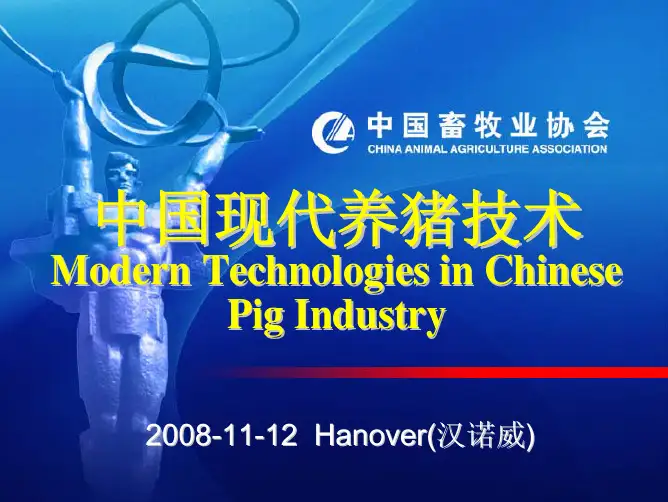
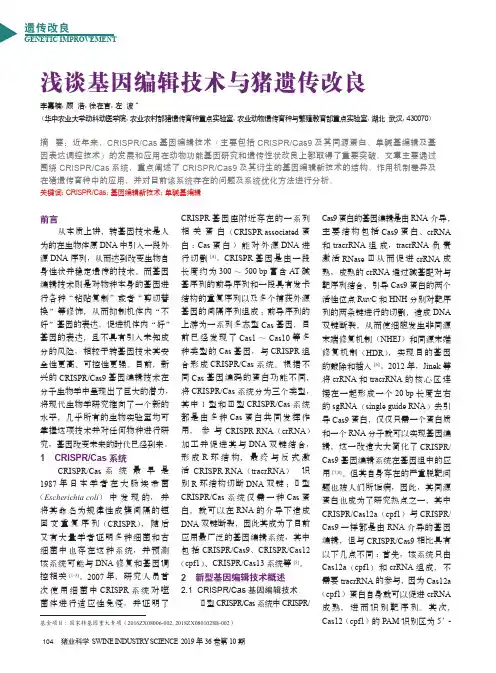
104猪业科学 SWINE INDUSTRY SCIENCE 2019年36卷第10期浅谈基因编辑技术与猪遗传改良李嘉楠,顾 浩,徐在言,左 波*(华中农业大学动科动医学院,农业农村部猪遗传育种重点实验室,农业动物遗传育种与繁殖教育部重点实验室,湖北 武汉,430070)摘 要:近年来,CRISPR/Cas 基因编辑技术(主要包括CRISPR/Cas9及其同源蛋白、单碱基编辑及基因表达调控技术)的发展和应用在动物功能基因研究和遗传性状改良上都取得了重要突破。
文章主要通过围绕CRISPR/Cas 系统,重点阐述了CRISPR/Cas9及其衍生的基因编辑新技术的结构、作用机制差异及在猪遗传育种中的应用,并对目前该系统存在的问题及系统优化方法进行分析。
关键词:CRISPR/Cas ;基因编辑新技术;单碱基编辑前言从本质上讲,转基因技术是人为的在生物体原DNA 中引入一段外源DNA 序列,从而达到改变生物自身性状并稳定遗传的技术。
而基因编辑技术则是对物种本身的基因进行各种“粘贴复制”或者“剪切替换”等修饰,从而抑制机体内“不好”基因的表达,促进机体内“好”基因的表达,且不具有引入未知成分的风险,相较于转基因技术其安全性更高、可控性更强。
目前,新兴的CRISPR/Cas9基因编辑技术在分子生物学中呈现出了巨大的潜力,将现代生物学研究推向了一个新的水平,几乎所有的生物实验室均可掌握这项技术并对任何物种进行研究,基因改变未来的时代已经到来。
1 CRISPR/Cas 系统CRISPR/Cas 系统最早是1987年日本学者在大肠埃希菌(Escherichia coli )中发现的,并将其命名为规律性成簇间隔的短回文重复序列(CRISPR ),随后又有大量学者证明多种细菌和古细菌中也存在这种系统,并预测该系统可能与DNA 修复和基因调控相关[1-3]。
2007年,研究人员首次使用细菌中CRISPR 系统对噬菌体进行适应性免疫,并证明了基金项目:国家转基因重大专项(2016ZX08006-002, 2018ZX0801028B-002)CRISPR 基因座附近存在的一系列相关蛋白(CRISPR associated 蛋白;Cas 蛋白)能对外源DNA 进行切割[4]。

猪场中常用到的英语专业术语一、不同阶段的猪专业词汇boar(公猪)gilt(后备母猪)sow(经产母猪)piglet(乳猪):特指尚没有断奶的小猪,国内称为仔猪的实际上包括未断奶的和已经断奶的,分别称为“哺乳仔猪”和“断奶仔猪”,用“仔培猪”这样的名称更是少见。
weaning(断奶)weaner(断奶猪):断奶后的猪只——一般是18-24日龄直到30公斤。
Pre-starter (断奶前仔猪)Starte(断奶仔猪)grower(生长猪):指大于30公斤的猪只——也称为feeder pig。
finisher(育成猪):指大于60公斤的猪只,故称为肥育猪或育肥猪是不恰当的。
mummified piglet(木乃伊猪):在怀孕期间死亡的胎儿以木乃伊的状态被产出。
有些文献上称“产木乃伊”是不正确的,应该是“产木乃伊胎”。
Yorkshire 大白Duroc 杜洛克Hampshire 汉普夏Landrace 长白Farrow to wean出生到断奶Wean to feeder断奶到育肥Farrow to feeder出生到育肥Feeder to finish 育肥到育成Farrow to finish出生到育成二、养繁殖中常用专业词汇farrowing(产仔):母猪产小猪的过程-即分娩(parturition)。
Introducing control 引种控制Segregated early weaning 早期断奶lactating(泌乳):母猪产生乳汁的过程。
gestating(怀孕期):从断奶后配种到产仔的一段时间(即干乳期)。
litter(窝):从同一头母猪一次产出的一群仔猪。
parity(胎次):每个胎次就是指每一次分娩——如:第三胎是指母猪产的第三窝。
stillborn(死产):产出死亡的胎儿。
fostering(寄养):将仔猪在不同的母猪间饲喂以获得更多的乳汁。
colostrum(初乳):分娩后最初几天产生的乳汁——含有较多抗体和其它因子。
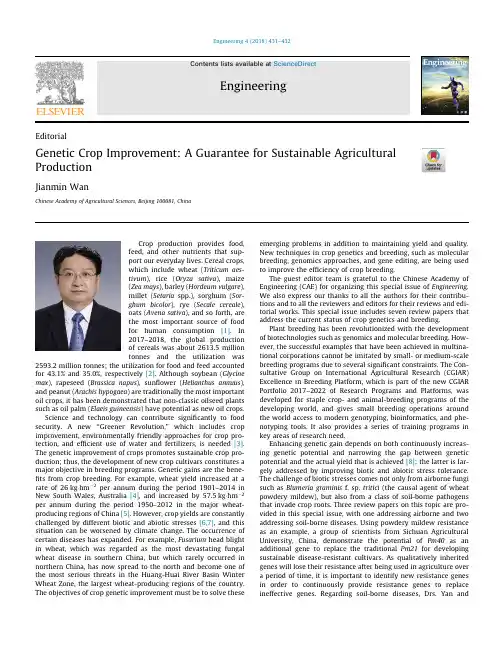
EditorialGenetic Crop Improvement:A Guarantee for Sustainable AgriculturalProductionJianmin WanChinese Academy of2593.2million tonnes;the utilization for food and feed accountedfor43.1%and35.0%,respectively[2].Although soybean(Glycinemax),rapeseed(Brassica napus),sunflower(Helianthus annuus),and peanut(Arachis hypogaea)are traditionally the most importantoil crops,it has been demonstrated that non-classic oilseed plantssuch as oil palm(Elaeis guineensis)have potential as new oil crops.Science and technology can contribute significantly to foodsecurity.A new‘‘Greener Revolution,”which includes cropimprovement,environmentally friendly approaches for crop pro-tection,and efficient use of water and fertilizers,is needed[3].The genetic improvement of crops promotes sustainable crop pro-duction;thus,the development of new crop cultivars constitutes amajor objective in breeding programs.Genetic gains are the bene-fits from crop breeding.For example,wheat yield increased at arate of26kgÁhmÀ2per annum during the period1901–2014inNew South Wales,Australia[4],and increased by57.5kgÁhmÀ2per annum during the period1950–2012in the major wheat-producing regions of China[5].However,crop yields are constantlychallenged by different biotic and abiotic stresses[6,7],and thissituation can be worsened by climate change.The occurrence ofcertain diseases has expanded.For example,Fusarium head blightin wheat,which was regarded as the most devastating fungalwheat disease in southern China,but which rarely occurred innorthern China,has now spread to the north and become one ofthe most serious threats in the Huang-Huai River Basin WinterWheat Zone,the largest wheat-producing regions of the country.The objectives of crop genetic improvement must be to solve thesebreeding programs due to several significant constraints.The Con-sultative Group on International Agricultural Research(CGIAR)Excellence in Breeding Platform,which is part of the new CGIARPortfolio2017–2022of Research Programs and Platforms,wasdeveloped for staple crop-and animal-breeding programs of thedeveloping world,and gives small breeding operations aroundthe world access to modern genotyping,bioinformatics,and phe-notyping tools.It also provides a series of training programs inkey areas of research need.Enhancing genetic gain depends on both continuously increas-ing genetic potential and narrowing the gap between geneticpotential and the actual yield that is achieved[8];the latter is lar-gely addressed by improving biotic and abiotic stress tolerance.The challenge of biotic stresses comes not only from airborne fungisuch as Blumeria graminis f.sp.tritici(the causal agent of wheatpowdery mildew),but also from a class of soil-borne pathogensthat invade crop roots.Three review papers on this topic are pro-vided in this special issue,with one addressing airborne and twoaddressing soil-borne ing powdery mildew resistanceas an example,a group of scientists from Sichuan AgriculturalUniversity,China,demonstrate the potential of Pm40as anadditional gene to replace the traditional Pm21for developingsustainable disease-resistant cultivars.As qualitatively inheritedgenes will lose their resistance after being used in agriculture overa period of time,it is important to identify new resistance genesin order to continuously provide resistance genes to replaceineffective genes.Regarding soil-borne diseases,Drs.Yan andBaidoo from North Dakota State University,USA,summarize the improvements that have been made in resistance to soybean cyst nematode(Heterodera glycines)through breeding.They provide an example of how the molecular biology of pathogens and related studies can be used to expedite conventional breeding programs.A group of scientists from the University of Alberta,Canada,review the occurrence and control measures of root rot,a soil-borne dis-ease infield pea that is caused by Aphanomyces euteiches,and that presents a significant threat to Canadianfield pea production.Global climate change caused by greenhouse gas emissions has largely contributed to adverse changes in temperature and precip-itation.One significant impact on crop production that is caused by global warming—drought stress—may result in a significant loss of yield for many crops.Developing crops that are adapted to the changing climate is an important task for crop geneticists and breeders.The paper contributed to this special issue by Dr.Nazim Ud Dowla and his colleagues from Australia reports on the adaption of wheat to drought stress by altering the key genes that control vernalization(Vrn),photoperiod(Ppd),and dwarfing(Rht) traits.To meet the demands of the increasing global population while protecting natural environments,it is critical to develop high-yielding and environmentally friendly crops,including those with improved traits,new crop types,or new products.New crop spe-cies,types,and products can be created through the development of synthetic crop species or crops with significantly changed pro-duction modes,such as a change from annual to perennial[9]. Three review papers published in this special issue provide examples of such efforts in plant breeding.A paper by scientists from China and the United States reports on the development of perennial wheat,which has long been an objective of several breeding programs in different countries.This article summarizes the production and potential application of perennial wheat via crossing wheat with perennial wheatgrasses.A review provided by a joint group of scientists from China and the International Maize and Wheat Improvement Center(CIMMYT)summarizes the potential application of synthetic hexaploid wheat in wheat breeding.The newly developed synthetic wheat provides useful genetic resources that are needed for wheat improvement.A paper by a group of scientists from the Commonwealth Scientific and Industrial Research Organization(CSIRO),Australia,reports on the genetic manipulation of non-classic oilseed plants to enhance their potential as a biofactory for the production of triacylglycerol as the dominant form of vegetable oil.The authors summarize current genetic engineering strategies to increase triacylglycerol accumulation in plants.References[1]Food and Agriculture Organization of the United Nations.Food and nutrition innumbers2014.Rome:Food and Agriculture Organization of the United Nations;2014.[2]Bedford D,Claro J,Giusti AM,Karumathy G,Lucarelli L,Mancini D,et al.Foodoutlook:biannual report on global food markets.Rome:Food and Agriculture Organization of the United Nations;2017.[3]Beddington J.Food security:contributions from science to a new and greenerrevolution.Philos Trans R Soc Lond B Biol Sci2010;365(1537):61–71.[4]Flohr BM,Hunt JR,Kirkegaard JA,Evans JR,Swan A,Rheinheimer B.Geneticgains in NSW wheat cultivars from1901to2014as revealed from synchronous flowering during the optimum period.Eur J Agron2018;98:1–13.[5]Gao FM,Ma DY,Yin GH,Rasheed A,Dong Y,Xiao YG,et al.Genetic progress ingrain yield and physiological traits in Chinese wheat cultivars of southern Yellow and Huai Valley since1950.Crop Sci2017;57(2):760–73.[6]Dai AG.Drought under global warming:a review.WIREs Clim Change2011;2(1):45–65.[7]Singh RP,Singh PK,Rutkoshi J,Hodson DP,He XY,Jørgensen LN,et al.Diseaseimpact on wheat yield potential and prospects of genetic control.Annu Rev Phytopathol2016;54:303–22.[8]Xu Y,Li P,Zou C,Lu Y,Xie C,Zhang X,et al.Enhancing genetic gain in the era ofmolecular breeding.J Exp Bot2017;68(11):2641–66.[9]Glover JD,Reganold JP,Bell LW,Borevitz J,Brummer EC,Buckler ES,et al.Increased food and ecosystem security via perennial grains.Science2010;328 (5986):1638–9.432J.Wan/Engineering4(2018)431–432Engineering 2 (2016) xxx–xxxEditorial作物遗传改良——农业可持续发展的保证万建民Chinese Academy of Agricultural Sciences, Beijing 100081, China作物生产提供了我们日常生活的食物、饲料和其他营养物质。
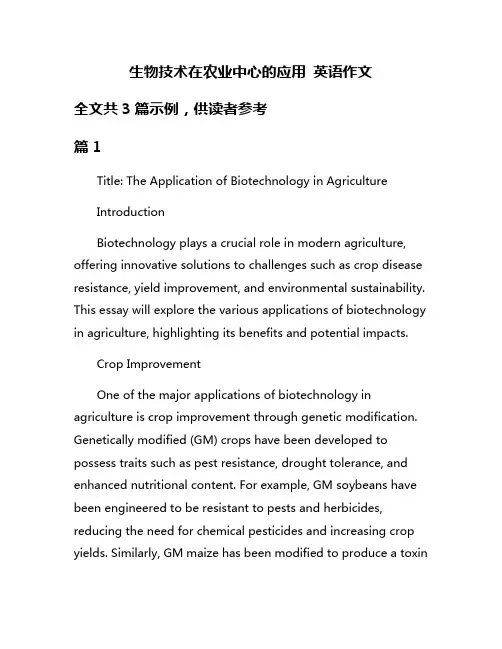
生物技术在农业中心的应用英语作文全文共3篇示例,供读者参考篇1Title: The Application of Biotechnology in AgricultureIntroductionBiotechnology plays a crucial role in modern agriculture, offering innovative solutions to challenges such as crop disease resistance, yield improvement, and environmental sustainability. This essay will explore the various applications of biotechnology in agriculture, highlighting its benefits and potential impacts.Crop ImprovementOne of the major applications of biotechnology in agriculture is crop improvement through genetic modification. Genetically modified (GM) crops have been developed to possess traits such as pest resistance, drought tolerance, and enhanced nutritional content. For example, GM soybeans have been engineered to be resistant to pests and herbicides, reducing the need for chemical pesticides and increasing crop yields. Similarly, GM maize has been modified to produce a toxinthat is lethal to insect pests but harmless to humans, reducing crop losses due to pest damage.Disease ResistanceBiotechnology has also been used to develop crops that are resistant to plant diseases. For example, a genetically modified variety of papaya has been created to resist the papaya ringspot virus, which devastated papaya crops in Hawaii in the 1990s. This disease-resistant papaya has helped revive the papaya industry in Hawaii and reduce farmers' reliance on chemical pesticides.Environmental SustainabilityBiotechnology can also contribute to environmental sustainability in agriculture. For example, genetically engineered crops can be designed to require fewer inputs such as water, fertilizers, and pesticides, reducing the environmental impact of agriculture. Additionally, biotechnology can be used to develop crops that are better suited to extreme climates, such as drought-resistant wheat varieties that can thrive in arid regions.Challenges and ConcernsDespite its benefits, the widespread adoption of biotechnology in agriculture has raised concerns about its potential risks. Some critics argue that genetically modified cropsmay have unintended effects on ecosystems and human health, while others raise ethical concerns about the ownership and control of genetic resources. Additionally, the use of biotechnology in agriculture may exacerbate existing inequalities in access to technology and resources, particularly in developing countries.ConclusionIn conclusion, biotechnology has the potential to revolutionize agriculture by improving crop productivity, disease resistance, and environmental sustainability. However, the responsible and ethical application of biotechnology in agriculture requires careful consideration of its potential risks and impacts. By addressing these concerns and leveraging the benefits of biotechnology, we can create a more sustainable and resilient agricultural system for the future.篇2Biotechnology in Agricultural CentersBiotechnology, particularly in the field of agriculture, has revolutionized the way we produce food and manage crops. With the help of advanced genetic engineering techniques, scientists are now able to develop new crop varieties withimproved resistance to diseases and pests, as well as increased yields and nutritional value. These advancements have brought about numerous benefits to farmers, consumers, and the environment.One of the key applications of biotechnology in agriculture is the development of genetically modified organisms (GMOs). GMOs are plants or animals that have had their DNA altered in a laboratory to give them desired traits, such as resistance to herbicides or pests. This technology has been widely adopted by farmers around the world, leading to increased crop yields and reduced pesticide use.Another important application of biotechnology in agriculture is the development of genetically modified crops that are resistant to certain diseases. For example, scientists have created varieties of potatoes that are resistant to late blight, a devastating disease that can destroy entire crops. By planting these disease-resistant crops, farmers can protect their harvests and improve their yields.Biotechnology has also been used to develop crops with improved nutritional value. For example, scientists have created varieties of rice that are fortified with essential nutrients such as vitamin A and iron. These biofortified crops can help combatmalnutrition in developing countries where people may not have access to a diverse diet.In addition to improving crop production, biotechnology has also been used to develop sustainable farming practices. For example, scientists have created genetically modified crops that are able to grow in harsh conditions, such as drought or salinity. These crops can help farmers in arid regions or salt-affected soils to maintain their livelihoods and adapt to changing climate conditions.Furthermore, biotechnology has the potential to address environmental challenges in agriculture. For example, scientists are researching the use of genetically modified microbes to improve soil health and fertility, reduce the need for chemical fertilizers, and promote sustainable farming practices. By harnessing the power of biotechnology, we can create a more resilient and sustainable agricultural system that benefits both people and the planet.In conclusion, biotechnology has transformed the agricultural industry by providing innovative solutions to improve crop production, enhance food security, and promote sustainable farming practices. With continued research and development in this field, we can unlock even more potential forbiotechnology to address global challenges such as climate change, population growth, and food insecurity. By harnessing the power of biotechnology, we can build a more sustainable and resilient agricultural system that benefits both current and future generations.篇3The Application of Biotechnology in AgricultureBiotechnology, the use of living organisms or their derivatives to develop products and processes, has revolutionized the field of agriculture in recent years. Through genetic engineering, researchers have been able to create crops that are resistant to pests and diseases, have increased yields, and are more nutritious. This has not only benefited farmers in terms of higher crop productivity and reduced pesticide usage, but has also had a positive impact on the environment and human health.One of the most well-known applications of biotechnology in agriculture is the development of genetically modified (GM) crops. These crops have been engineered to possess desirable traits such as resistance to pests, diseases, and herbicides, as well as increased tolerance to environmental stresses such as droughtand salinity. This has allowed farmers to produce more food on less land, using fewer resources and chemicals.GM crops have also been developed to improve the nutritional content of food. For example, golden rice, which has been genetically modified to produce beta-carotene, a precursor of vitamin A, has the potential to reduce vitamin A deficiency in developing countries where rice is a staple food. Similarly, biofortified crops have been developed to increase the levels of essential nutrients such as iron, zinc, and vitamin C in staple crops like wheat, maize, and cassava.In addition to genetic engineering, biotechnology is also being used in agriculture for other purposes such as crop breeding, disease diagnostics, and pest control. For example, marker-assisted breeding allows researchers to identify and select plants with desirable traits more quickly and accurately, speeding up the breeding process. Biotechnology is also being used to develop diagnostic tools for detecting plant diseases and pests, enabling farmers to take proactive measures to prevent outbreaks and reduce crop losses.Furthermore, biotechnology has the potential to address some of the challenges facing agriculture today, such as climate change, food insecurity, and soil degradation. By developingcrops that are more resilient to changing environmental conditions, researchers can help farmers adapt to climate change and ensure food security for future generations. Biotechnology can also help improve soil health by developing crops that require fewer fertilizers and pesticides, reducing environmental pollution and promoting sustainable agriculture practices.Despite the many benefits of biotechnology in agriculture, there are also concerns about its potential risks and ethical implications. Critics argue that GM crops may have unintended consequences on the environment and human health, and that farmers in developing countries may become dependent on multinational corporations for seeds and technology. It is important for regulators and policymakers to carefully evaluate the risks and benefits of biotechnology in agriculture and ensure that it is used responsibly and ethically.In conclusion, biotechnology has the potential to transform agriculture and address many of the challenges facing the industry today. By developing crops that are resistant to pests and diseases, have increased yields, and are more nutritious, researchers can help farmers produce more food in a more sustainable and efficient manner. However, it is important to continue research and monitoring of biotechnology inagriculture to ensure that it is safe, ethical, and beneficial for both farmers and consumers.。
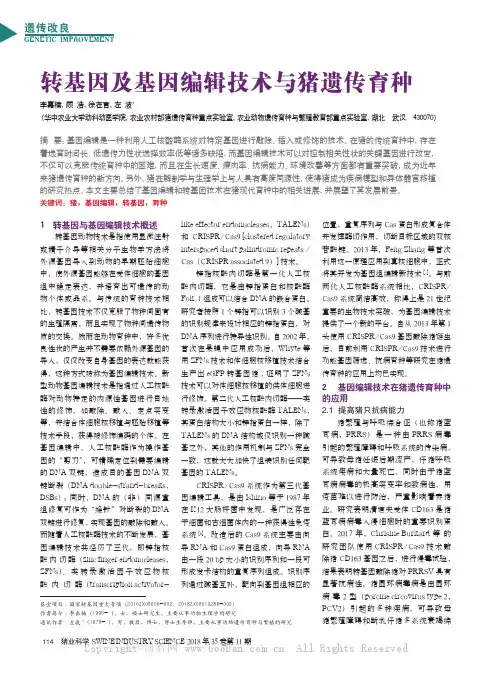
114猪业科学 SWINE INDUSTRY SCIENCE 2018年35卷第11期遗传改良GENETIC IMPROVEMENT北京顺鑫农业小店种猪分公司协办转基因及基因编辑技术与猪遗传育种李嘉楠,顾 浩,徐在言,左 波*(华中农业大学动科动医学院,农业农村部猪遗传育种重点实验室,农业动物遗传育种与繁殖教育部重点实验室,湖北 武汉 430070)摘 要:基因编辑是一种利用人工核酸酶系统对特定基因进行敲除、插入或修饰的技术。
在猪的传统育种中,存在着选育时间长、低遗传力性状选择效率低等诸多缺陷,而基因编辑技术可以对控制相关性状的关键基因进行改变,不仅可以克服传统育种中的困难,而且在生长速度、瘦肉率、抗病能力、环境改善等方面都有重要突破,成为近年来猪遗传育种的新方向。
另外,猪在解剖学与生理学上与人具有高度同源性,使得猪成为疾病模型和异体器官移植的研究热点。
本文主要总结了基因编辑和转基因技术在猪现代育种中的相关进展,并展望了其发展前景。
关键词:猪;基因编辑;转基因;育种基金项目:国家转基因重大专项(2016ZX08006-002, 2018ZX0801028B-002)作者简介:李嘉楠(1995- ),女,硕士研究生,主要从事动物生理学的研究通讯作者:左波*(1978- ),男,教授,博士,博士生导师,主要从事动物遗传育种与繁殖的研究1 转基因与基因编辑技术概述转基因动物技术是指使用显微注射或精子介导等相关分子生物学方法将外源基因导入到动物的早期胚胎细胞中,使外源基因能够在受体细胞的基因组中稳定表达,并培育出可遗传的动物个体或品系。
与传统的育种技术相比,转基因技术不仅克服了物种间固有的生殖隔离,而且实现了物种间遗传物质的交换。
然而在动物育种中,许多优良性状的产生并不需要依赖外源基因的导入,仅仅改变自身基因的表达就能获得,这种方式被称为基因编辑技术。
新型动物基因编辑技术是指通过人工核酸酶对动物特定的内源性基因进行目地性的修饰,如敲除、敲入、定点突变等,并结合体细胞核移植与胚胎移植等技术手段,获得被修饰编码的个体。
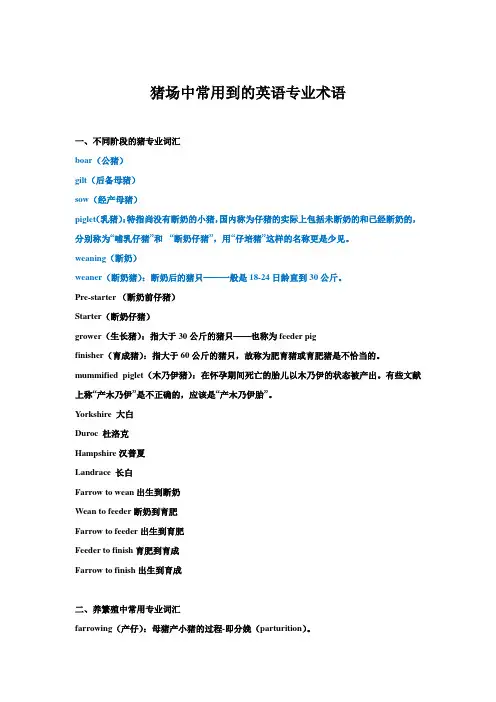
猪场中常用到的英语专业术语一、不同阶段的猪专业词汇boar(公猪)gilt(后备母猪)sow(经产母猪)piglet(乳猪):特指尚没有断奶的小猪,国内称为仔猪的实际上包括未断奶的和已经断奶的,分别称为“哺乳仔猪”和“断奶仔猪”,用“仔培猪”这样的名称更是少见。
weaning(断奶)weaner(断奶猪):断奶后的猪只——一般是18-24日龄直到30公斤。
Pre-starter (断奶前仔猪)Starter(断奶仔猪)grower(生长猪):指大于30公斤的猪只——也称为feeder pigfinisher(育成猪):指大于60公斤的猪只,故称为肥育猪或育肥猪是不恰当的。
mummified piglet(木乃伊猪):在怀孕期间死亡的胎儿以木乃伊的状态被产出。
有些文献上称“产木乃伊”是不正确的,应该是“产木乃伊胎”。
Yorkshire 大白Duroc 杜洛克Hampshire 汉普夏Landrace 长白Farrow to wean出生到断奶Wean to feeder断奶到育肥Farrow to feeder出生到育肥Feeder to finish 育肥到育成Farrow to finish出生到育成二、养繁殖中常用专业词汇farrowing(产仔):母猪产小猪的过程-即分娩(parturition)。
Introducing control 引种控制Segregated early weaning 早期断奶lactating(泌乳):母猪产生乳汁的过程。
gestating(怀孕期):从断奶后配种到产仔的一段时间(即干乳期)。
litter(窝):从同一头母猪一次产出的一群仔猪。
parity(胎次):每个胎次就是指每一次分娩——如:第三胎是指母猪产的第三窝。
stillborn(死产):产出死亡的胎儿。
fostering(寄养):将仔猪在不同的母猪间饲喂以获得更多的乳汁。
colostrum(初乳):分娩后最初几天产生的乳汁——含有较多抗体和其它因子。
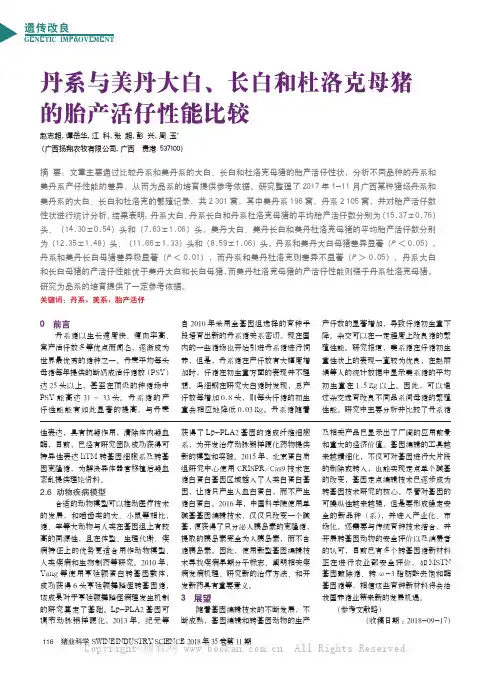
116猪业科学 SWINE INDUSTRY SCIENCE 2018年35卷第11期遗传改良GENETIC IMPROVEMENT 北京顺鑫农业小店种猪分公司协办0 前言丹系猪以生长速度快、瘦肉率高、窝产活仔数多等优点而闻名,逐渐成为世界最优秀的猪种之一。
丹麦平均每头母猪每年提供的断奶成活仔猪数(PSY)达25头以上,甚至在顶级的种猪场中PSY 能高达31~33头。
丹系猪的产仔性能能有如此显著的提高,与丹麦丹系与美丹大白、长白和杜洛克母猪的胎产活仔性能比较赵志超,谭岳华,江 科,张 超,彭 兴,周 玉*(广西扬翔农牧有限公司,广西 贵港 537100)摘 要:文章主要通过比较丹系和美丹系的大白、长白和杜洛克母猪的胎产活仔性状,分析不同品种的丹系和美丹系产仔性能的差异,从而为品系的培育提供参考依据。
研究整理了2017年1-11月广西某种猪场丹系和美丹系的大白、长白和杜洛克的繁殖记录,共2 301窝,其中美丹系196窝,丹系2 105窝,并对胎产活仔数性状进行统计分析。
结果表明:丹系大白、丹系长白和丹系杜洛克母猪的平均胎产活仔数分别为(15.37±0.76)头、(14.30±0.54)头和(7.63±1.06)头。
美丹大白、美丹长白和美丹杜洛克母猪的平均胎产活仔数分别为(12.35±1.48)头、(11.66±1.33)头和(8.59±1.06)头。
丹系和美丹大白母猪差异显著(P <0.05),丹系和美丹长白母猪差异极显著(P <0.01),而丹系和美丹杜洛克则差异不显著(P >0.05)。
丹系大白和长白母猪的产活仔性能优于美丹大白和长白母猪,而美丹杜洛克母猪的产活仔性能则强于丹系杜洛克母猪。
研究为品系的培育提供了一定参考依据。
关键词:丹系;美系;胎产活仔自2010年采用全基因组选择的育种手段培育出新的丹系猪关系密切。
现在国内的一些猪场也开始引进丹系猪进行饲养,但是,丹系猪在产仔数有大幅度增加时,仔猪在初生重方面的表现并不理想。
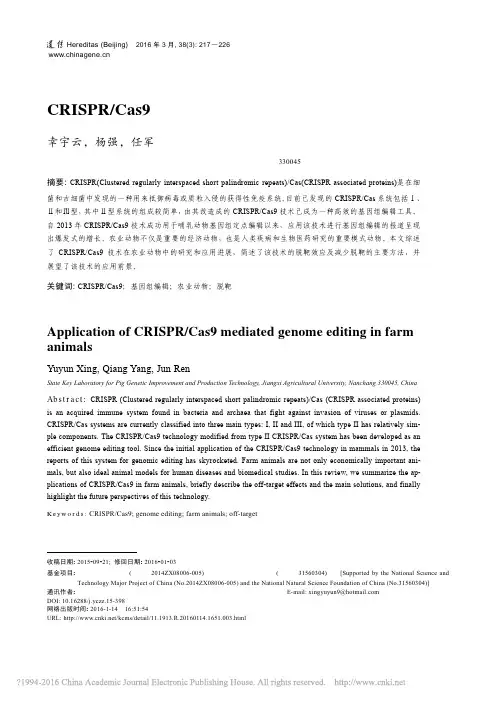
Hereditas (Beijing) 2016年3月, 38(3): 217―226 综 述收稿日期: 2015-09-21; 修回日期: 2016-01-03基金项目:国家科技重大专项(编号:2014ZX08006-005)和国家自然科学基金项目(编号:31560304)资助[Supported by the National Science andTechnology Major Project of China (No.2014ZX08006-005) and the National Natural Science Foundation of China (No.31560304)]通讯作者:幸宇云,副研究员,研究方向:动物遗传育种与繁殖、动物转基因技术。
E-mail: xingyuyun9@ DOI: 10.16288/j.yczz.15-398 网络出版时间: 2016-1-14 16:51:54URL: /kcms/detail/11.1913.R.20160114.1651.003.htmlCRISPR/Cas9基因组编辑技术在农业动物中的应用幸宇云,杨强,任军江西农业大学,省部共建猪遗传改良与养殖技术国家重点实验室,南昌330045摘要: CRISPR(Clustered regularly interspaced short palindromic repeats)/Cas(CRISPR associated proteins)是在细菌和古细菌中发现的一种用来抵御病毒或质粒入侵的获得性免疫系统。
目前已发现的CRISPR/Cas 系统包括Ⅰ、Ⅱ和Ⅲ型,其中Ⅱ型系统的组成较简单,由其改造成的CRISPR/Cas9技术已成为一种高效的基因组编辑工具。
自2013年CRISPR/Cas9技术成功用于哺乳动物基因组定点编辑以来,应用该技术进行基因组编辑的报道呈现出爆发式的增长。
农业动物不仅是重要的经济动物,也是人类疾病和生物医药研究的重要模式动物。
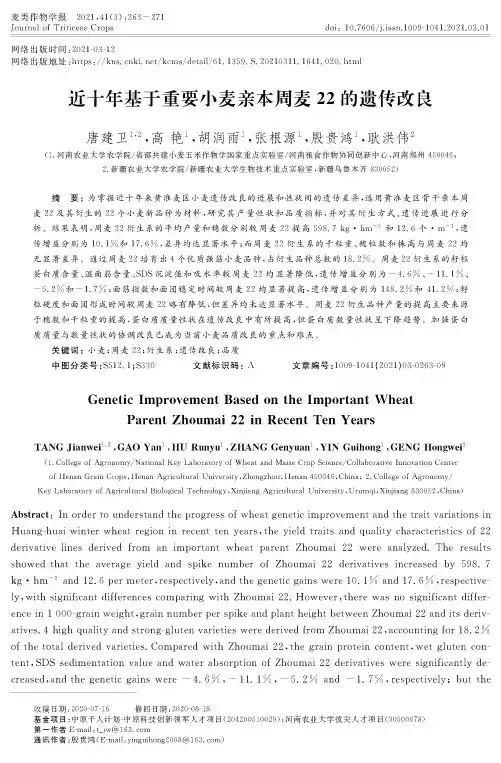
麦类作物学报2021,41(3):263—271Journal of Triticeae Crops doi:10.7606/j.issn.1009-1041.2021.03.01网络出版时间:2021-03-12网络出版地址:https://kns.c n /kcms/detail/61.1359.S.20210311.1641.020.html近十年基于重要小麦亲本周麦22的遗传改良唐建卫12,高艳】,胡润雨】,张根源】,殷贵鸿】,耿洪伟2(1.河南农业大学农学院/省部共建小麦玉米作物学国家重点实验室/河南粮食作物协同创新中心,河南郑州450046;2.新疆农业大学农学院/新疆农业大学生物技术重点实验室,新疆乌鲁木齐830052)摘要:为掌握近十年来黄淮麦区小麦遗传改良的进展和性状间的遗传差异,选用黄淮麦区骨干亲本周麦22及其衍生的22个小麦新品种为材料,研究其产量性状和品质指标,并对其衍生方式、遗传进展进行分析。
结果表明,周麦22衍生系的平均产量和穗数分别较周麦22提高59&7kg•hm—2和12.6个・m—1,遗传增益分别为10.1%和17.6%,差异均达显著水平;而周麦22衍生系的千粒重、穗粒数和株高与周麦22均无显著差异。
通过周麦22培育出4个优质强筋小麦品种,占衍生品种总数的18.2%。
周麦22衍生系的籽粒蛋白质含量、湿面筋含量、SDS沉淀值和吸水率较周麦22均显著降低,遗传增益分别为一4.6%、一11.1%、—5.2%和一1.7%;面筋指数和面团稳定时间较周麦22均显著提高,遗传增益分别为14&2%和41.2%;籽粒硬度和面团形成时间较周麦22略有降低,但差异均未达显著水平。
周麦22衍生品种产量的提高主要来源于穗数和千粒重的提高,蛋白质质量性状在遗传改良中有所提高,但蛋白质数量性状呈下降趋势。
加强蛋白质质量与数量性状的协调改良已成为当前小麦品质改良的重点和难点。
关键词:小麦;周麦22;衍生系;遗传改良;品质中图分类号:S512.1;S330文献标识码:A文章编号:1009-1041(2021)03-0263-09Genetic Improvement Based on the Important WheatParent Zhoumai22in Recent Ten YearsTANG Jianwei1'2,GAO Yan1,HU Runyu1,ZHANG Genyuan1,YIN Guihong1,GENG Hongwei2(1.College of Agronomy/National Key Laboratory of Wheat and Maize Crop Science/Collaborative Innovation Centerof Henan Grain Crops,Henan Agricultural Universty,Zhengzhou,IIenan450046,China;2.College of Agronomy/ Key Laboratory of Agricultural Biological Technology,Xinjiang Agricultural Universty,Urumqi,Xinjiang830052,China)Abstract:In order to understand the progress of wheat genetic improvement and the trait variations in Huang-huai winter wheat region in recent ten years,the yield traits and quality characteristics of22 derivative lines derived from an important wheat parent Zhoumai22were analyzed.The results showed that the average yield and spike number of Zhoumai22derivatives increased by598.7 kg•hm—2and12.6per meter,respectively,and the genetic gains were10.1%and17.6%respectively,with sign讦ica_nt differences comparing with Zhoumai22.However there was no sign讦ica_nt differ-encein1000-grainweightgrainnumberperspikeandplantheightbetweenZhoumai22anditsderiv-atives.4high quality and strong—gluten varieties were derived from Zhoumai22,accounting for18.2% of the total derived pared with Zhoumai22,the grain protein content,wet gluten content,SDS sedimentation value and water absorption of Zhoumai22derivatives were significantly de-creased,and the genetic gains were—4.6%,—11.1%,—5.2%and—1.7%,respectively;but the收稿日期:2020-07-16修回日期:2020-08-18基金项目:中原千人计划-中原科技创新领军人才项目(204200510029);河南农业大学拔尖人才项目(30500678)第一作者E-mail:t_jw@通讯作者:殷贵鸿(E-mail:yinguihong2008@)・264・麦类作物学报第41卷gluten index and dough stability time were significantly increased,with genetic gains of148.2%and 41.2%,respectively;the grain hardness and dough development time were slightly lower than those of Zhoumai22,without significant difference.The increase of yield of Zhoumai22derivatives was mainly due to the increase of spike number and1000-grain weight.The protein quality traits were improved through genetic improvement,but the protein quantitative traits showed a downward trend. The coordination of protein quality and quantity traits has become the focus and dificulty in wheat quality breeding.Key words:Wheat;Zhoumai22;Derivatives;Genetic progress;Quality黄淮麦区是中国小麦主产区之一,其播种面积和产量均居全国首位[12]。
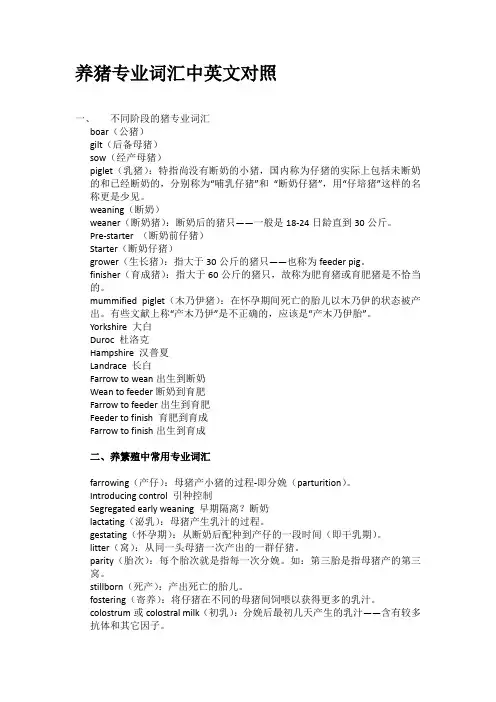
养猪专业词汇中英文对照一、不同阶段的猪专业词汇boar(公猪)gilt(后备母猪)sow(经产母猪)piglet(乳猪):特指尚没有断奶的小猪,国内称为仔猪的实际上包括未断奶的和已经断奶的,分别称为“哺乳仔猪”和“断奶仔猪”,用“仔培猪”这样的名称更是少见。
weaning(断奶)weaner(断奶猪):断奶后的猪只——一般是18-24日龄直到30公斤。
Pre-starter (断奶前仔猪)Starter(断奶仔猪)grower(生长猪):指大于30公斤的猪只——也称为feeder pig。
finisher(育成猪):指大于60公斤的猪只,故称为肥育猪或育肥猪是不恰当的。
mummified piglet(木乃伊猪):在怀孕期间死亡的胎儿以木乃伊的状态被产出。
有些文献上称“产木乃伊”是不正确的,应该是“产木乃伊胎”。
Yorkshire 大白Duroc 杜洛克Hampshire 汉普夏Landrace 长白Farrow to wean出生到断奶Wean to feeder断奶到育肥Farrow to feeder出生到育肥Feeder to finish 育肥到育成Farrow to finish出生到育成二、养繁殖中常用专业词汇farrowing(产仔):母猪产小猪的过程-即分娩(parturition)。
Introducing control 引种控制Segregated early weaning 早期隔离?断奶lactating(泌乳):母猪产生乳汁的过程。
gestating(怀孕期):从断奶后配种到产仔的一段时间(即干乳期)。
litter(窝):从同一头母猪一次产出的一群仔猪。
parity(胎次):每个胎次就是指每一次分娩。
如:第三胎是指母猪产的第三窝。
stillborn(死产):产出死亡的胎儿。
fostering(寄养):将仔猪在不同的母猪间饲喂以获得更多的乳汁。
colostrum或colostral milk(初乳):分娩后最初几天产生的乳汁——含有较多抗体和其它因子。
Good morning/afternoon/evening. It is my great pleasure to stand before you today to talk about the essential role that farm animals play in our lives. Farm animals are not just creatures that provide us with food and fiber; they are also our companions, our workers, and our protectors. In this speech, I will discuss the various types of farm animals, their contributions to agriculture, and the importance of sustainable farming practices that ensure their well-being.Introduction: The Importance of Farm AnimalsTo begin with, let us take a moment to appreciate the diversity of farm animals. From the majestic cows that grace our pastures to the industrious pigs that help us till the soil, farm animals come in all shapes and sizes. Each species has its unique characteristics and functions that contribute to the success of a farm.Types of Farm Animals and Their Roles1. Cattle: Cattle are perhaps the most iconic farm animals. They provide us with milk, beef, and leather. Their grazing habits help maintain the health of pastures, and they are also crucial for plowing fields due to their strong and sturdy nature.2. Pigs: Pigs are versatile animals that can be raised for pork, bacon, ham, and lard. They are intelligent and have a remarkable ability to convert food into edible meat. Additionally, pigs are excellent at foraging and can be used to control pests in agricultural settings.3. Dairy Cows: Dairy cows are a cornerstone of the dairy industry. They produce milk, which is a vital source of nutrition for people of all ages. The milk is used to make a variety of products, including cheese, yogurt, and butter.4. Sheep: Sheep are known for their wool, which is used to make clothing and insulation. They also provide meat, known as mutton, and their leather is used in various products. Sheep are excellent grazers and can thrive in a variety of environments.5. Chickens: Chickens are one of the most popular farm animals worldwide. They provide us with eggs, which are a rich source of protein and essential nutrients. Chicken meat, known as poultry, is a staple in many diets.6. Horses: Horses have been an integral part of agriculture for centuries. They are used for plowing, transportation, and even as companions. Their strength and agility make them invaluable in many farming operations.The Contributions of Farm Animals to Agriculture1. Food Production: The primary role of farm animals is to provide us with food. Their meat, milk, eggs, and fiber are essential components of our diet. Without them, our food supply would be severely limited.2. Soil Health: Many farm animals, such as cattle and sheep, help maintain soil health through their grazing habits. Their manure is rich in nutrients that can improve soil fertility and reduce the need for synthetic fertilizers.3. Biodiversity: Farm animals contribute to biodiversity by supporting a variety of plant and animal species. For example, bees are attracted to flowering crops, which they pollinate, leading to increased yields.Sustainable Farming PracticesIt is crucial that we adopt sustainable farming practices to ensure the well-being of farm animals and the environment. Here are some key practices:1. Animal Welfare: Providing proper care and attention to farm animalsis essential. This includes ensuring they have access to clean water, food, and shelter, as well as minimizing stress and pain.2. Genetic Improvement: Selective breeding can help improve the productivity and resilience of farm animals. This can lead to more sustainable farming practices and increased food security.3. Integrated Pest Management: Using integrated pest management techniques can reduce the need for chemical pesticides, which can be harmful to farm animals and the environment.4. Renewable Energy: Using renewable energy sources, such as solar and wind power, can reduce the carbon footprint of farming operations and contribute to a healthier planet.Conclusion: The Future of Farm AnimalsIn conclusion, farm animals are an invaluable part of our agricultural system. They provide us with food, fiber, and companionship, and their role in maintaining soil health and biodiversity cannot be overstated. As we move forward, it is essential that we continue to prioritize sustainable farming practices and ensure the well-being of farm animals. By doing so, we can create a more resilient and sustainable food system for future generations.Thank you for your attention. I welcome any questions you may have regarding the importance and care of farm animals.---This speech aims to cover the diverse roles of farm animals in agriculture, their contributions to society, and the importance of sustainable farming practices. It is structured to provide a comprehensive overview of the subject matter, ensuring that the speech meets the minimum word count requirement.。
熊猫猪猪国际牧场作文英文回答:The Pandas Pig Farm is a large-scale comprehensive breeding enterprise integrating scientific research, breeding, production and sales. The farm adheres to the development concept of scientific and ecological breeding, and is committed to building a modern, ecological and efficient breeding industry chain. The farm has a professional breeding team, advanced breeding technology and equipment, and a complete quality control system. The breeding pigs are all selected from high-quality breeding populations, and the breeding process is strictly controlled to ensure the genetic quality of the pigs. The farm also pays attention to the protection of the environment, and actively promotes the concept of green breeding. The farm has invested heavily in environmental protection facilities, and has passed the national environmental protection certification.The Pandas Pig Farm has a strong technical force, and has independently developed a number of core technologiesin breeding, breeding and disease prevention and control. The farm has also established long-term cooperative relationships with universities and research institutions, and has carried out a number of scientific research projects. The farm's research results have been widely used in the industry, and have made a significant contribution to the development of the pig industry.The Pandas Pig Farm has a complete marketing network, and its products are sold all over the country. The farm's products are well-received by consumers for their excellent quality and reasonable price. The farm has also established a number of flagship stores in major cities, providing consumers with a convenient and comfortable shopping experience.The Pandas Pig Farm is a leading enterprise in the pig industry, and has made significant contributions to the development of the industry. The farm is committed to providing consumers with safe, high-quality pork products,and actively assumes social responsibilities. The farm has been recognized by the industry and consumers, and has won numerous awards.中文回答:熊猫猪猪国际牧场是一家集科研、育种、生产、销售为一体的大型综合性养殖企业。
Plant Genetic Engineering for CropImprovementPlant genetic engineering for crop improvement has been a topic of great interest and controversy in recent years. This technology involves the manipulation of an organism's genetic material in order to introduce desirable traits or to remove undesirable ones. While some people see this as a promising way to address food security and environmental sustainability, others are concerned about the potential risks and ethical implications. In this essay, we will explore the potential benefits and drawbacks of plant genetic engineering for crop improvement. One of the main advantages of plant genetic engineering is the ability to create crops with improved resistance to pests and diseases. By introducing genes that encode for natural insecticides or disease resistance, scientists can help farmers reduce their reliance on chemical pesticides, thus minimizing the environmental impact of agriculture. Additionally, genetic engineering can also be used to enhance the nutritional content of crops, such as increasing the levels of vitamins or essential nutrients in staple foods like rice or wheat. Another potential benefit of plant genetic engineering is the ability to develop crops that are better adapted to environmental stressors, such as drought, salinity, or extreme temperatures. This could be particularly important in the face of climate change, as it may help ensure food security in regions that are prone to environmental fluctuations. By introducing genes that enable plants to thrive in challenging conditions, genetic engineering could help farmers maintain stable yields and incomes. Despite these potential benefits, plant genetic engineering for crop improvement also raises significant concerns. One major issue is the potential for unintended ecological consequences, such as the spread of genetically modified traits to wild relatives or non-target organisms. This could have unpredictable effects on ecosystems and biodiversity, and it is important to carefully assess and mitigate these risks before releasinggenetically engineered crops into the environment. Furthermore, there are also ethical considerations surrounding plant genetic engineering, particularly in the context of food safety and consumer choice. Some people are apprehensive aboutconsuming genetically modified foods due to concerns about long-term health effects, and there is ongoing debate about the transparency and labeling of genetically modified products. It is crucial to engage in open and transparent dialogue about these issues in order to address public concerns and ensure that regulatory frameworks are in place to protect consumer interests. In conclusion, plant genetic engineering holds great promise for crop improvement, offering potential benefits such as enhanced pest resistance, improved nutritional content, and environmental adaptation. However, it is important to proceed with caution and to carefully consider the potential risks and ethical implications associated with this technology. By engaging in rigorous risk assessment, transparent communication, and responsible regulation, we can harness the potential of plant genetic engineering while safeguarding the environment and public health.。
Plant Genetic Engineering for CropImprovementPlant Genetic Engineering for Crop Improvement Genetic engineering has been a hot topic in the field of agriculture for decades. With the advancement of technology, scientists have been able to manipulate the genetic makeup of plants in order to improve crop yield, resistance to diseases, and overall quality. This essay will explore the benefits and potential drawbacks of plant genetic engineering for crop improvement. To begin with, one of the major advantages of plant genetic engineering is the ability to create crops that are more resistant to pests and diseases. By introducing genes from other organisms that have natural resistance to certain pests, scientists can create crops that require less pesticide use, resulting in a more environmentally friendly and cost-effective farming practice. Furthermore, genetic engineering can also lead to crops with improved nutritional value. For example, scientists have been able to enhance the vitamin content of certain crops, making them more nutritious for human consumption. This has the potential to address malnutrition issues in developing countries and improve overall public health. In addition, genetic engineering can also help to increase crop yield and overall productivity. By introducing genes that promote faster growth and larger fruit or grain production, farmers can benefit from higher yields and increased profits. This is especially important in a world with a growing population and increasing food demand. However, it is important to consider the potential drawbacks of plant genetic engineering. One concern is the impact on biodiversity, as genetically modified crops may outcompete and replace native plant species. This could have negative consequences for ecosystems and the organisms that depend on native plants for survival. Another potential issue is the long-term effects of consuming genetically modified crops. While extensive testing is done to ensure the safety of these crops, there is still some uncertainty about the potential health risks of consuminggenetically modified foods over a lifetime. In conclusion, plant genetic engineering has the potential to bring about significant improvements in crop yield, resistance to pests and diseases, and nutritional value. However, it isimportant to carefully consider the potential drawbacks and ensure that proper regulations and testing are in place to minimize any negative impacts on the environment and human health. As technology continues to advance, it will be crucial to approach plant genetic engineering with caution and consideration for the long-term effects on agriculture and society as a whole.。
Plant Genetic Engineering for CropImprovementPlant genetic engineering for crop improvement has been a topic of great interest and controversy in the field of agriculture. The ability to modify the genetic makeup of plants to enhance their traits, such as resistance to pests and diseases, tolerance to environmental stresses, and increased yield, has the potential to address food security challenges and improve agricultural sustainability. However, the use of genetic engineering in crops also raises concerns about the potential impact on human health, the environment, and the socioeconomic dynamics of farming communities. From a scientific perspective, plant genetic engineering offers a promising tool for addressing the challenges faced by modern agriculture. By introducing specific genes into crop plants, scientists can confer desirable traits that may not be readily available in the plant's natural gene pool. For example, the introduction of genes for insect resistance can reduce the reliance on chemical pesticides, leading to a more sustainable and environmentally friendly approach to pest management. Similarly, genes for drought tolerance or nutrient efficiency can help plants thrive in adverse growing conditions, ultimately improving crop productivity and resilience. Furthermore, genetic engineering can also be used to enhance the nutritionalquality of crops, addressing malnutrition and dietary deficiencies in many partsof the world. For instance, the biofortification of staple crops with essential vitamins and minerals can contribute to improving public health and reducing the prevalence of nutrient-related diseases. These potential benefits highlight the significant role that plant genetic engineering can play in addressing global food security and public health challenges. However, the widespread adoption of genetically engineered crops has been met with skepticism and opposition from various stakeholders, including consumers, environmentalists, and some segments of the agricultural community. One of the primary concerns is the potential environmental impact of genetically modified (GM) crops, including the unintended spread of modified genes to wild plant populations and the disruption of ecosystems. Additionally, the long-term effects of GM crops on soil health,biodiversity, and non-target organisms remain a subject of debate and ongoing research. From an ethical and social perspective, the introduction of GM crops also raises questions about the control and ownership of agricultural resources. The patenting of genetically modified seeds and the concentration of biotechnology companies in the seed industry have led to concerns about the socioeconomic implications for farmers, particularly in developing countries. The dependence on proprietary seeds and associated technologies can limit farmers' autonomy and exacerbate inequalities in access to agricultural innovation and resources. Moreover, the potential risks to human health associated with the consumption of GM crops have been a point of contention. While regulatory agencies have deemed most GM crops safe for human consumption, concerns about allergenicity, toxicity, and the transfer of antibiotic resistance genes persist among some consumers and health advocates. The lack of long-term studies on the health effects of GM crops has contributed to the uncertainty and public distrust surrounding their widespread use in the food supply. In conclusion, plant genetic engineering holds great potential for crop improvement and addressing the challenges of modern agriculture. However, the adoption of genetically modified crops must be approached with caution, considering the complex interplay of scientific, environmental, ethical, and social factors. As the technology continues to evolve, it is essential to engage in informed and inclusive dialogues that weigh the potential benefits against the potential risks and address the concerns of various stakeholders. Ultimately, a balanced and evidence-based approach to plant genetic engineering is necessary to harness its full potential for sustainable and equitable agricultural development.。
农场英语作文Farm。
A farm is a piece of land used for growing crops and raising animals for food and other products. It is an essential part of the agricultural industry and plays a crucial role in providing food for human consumption.Farms can vary in size and scope, ranging from small family-owned operations to large commercial enterprises. Regardless of their size, farms are typically divided into different sections for various purposes, such as crop fields, pastureland, and barns for livestock.Crop fields are used for growing a wide variety of plants, including grains, fruits, and vegetables. Different crops require different growing conditions, so farmers must carefully plan and manage their fields to ensure successful harvests. This involves tasks such as plowing, planting, watering, and fertilizing the soil. Additionally, farmersmust monitor their crops for pests and diseases and take appropriate measures to protect them.Livestock is another important aspect of many farms. Animals such as cows, pigs, chickens, and sheep are raised for their meat, milk, eggs, and other products. Proper care and management of livestock are essential for their health and well-being. This includes providing them with adequate food, water, shelter, and medical attention when necessary. Farmers also need to ensure that their animals are treated humanely and in accordance with ethical and legal standards.In addition to growing crops and raising animals, farms often engage in other activities such as beekeeping, aquaculture, and agroforestry. These practices contributeto the diversity and sustainability of agricultural production and can provide additional sources of income for farmers.Modern farms are increasingly incorporating technology and innovation to improve efficiency and productivity. This includes the use of machinery for planting and harvesting,irrigation systems for water management, and genetic engineering for crop and livestock improvement. Furthermore, sustainable farming practices such as organic farming and permaculture are gaining popularity as people become more conscious of environmental and health concerns.Farms also play a vital role in rural economies, providing employment opportunities and contributing tolocal communities. Many farms offer agritourism activities, allowing visitors to experience farm life and learn about agricultural practices. This not only generates additional income for farmers but also promotes a greaterunderstanding and appreciation of where our food comes from.In conclusion, farms are essential for producing the food and resources that sustain human life. They require careful planning, hard work, and dedication, but therewards are invaluable. As the world's population continues to grow, the importance of farms in ensuring food security and sustainability cannot be overstated. It is crucial to support and promote responsible farming practices to ensure a bright and prosperous future for generations to come.。
Genetic improvement for important farmed aquaculturespecies with a reference to carp,tilapia and prawns in Asia:achievements,lessons and challengesNguyen Hong NguyenUniversity of the Sunshine Coast,Maroochydore,Qld 4558,AustraliaAbstractThis study provides an overview of successful genetic improvement programmes for important farmed aquaculture species in Asia,with a focus on lessons and experi-ences gained as well as challenges remaining.In both fish and prawns (Macrobrach-ium rosenbergii ),conventional selective breeding approaches have resulted in significant improvement in productivity,with genetic gains ranging from 8to 12%per generation.Selection for high growth has also brought about beneficial changes in fillet weight of fish and edible meat in prawns without detrimental effects on flesh quality attributes and fitness-related traits.Genetically improved animals show remarkable vigour and high adaptation to a range of culture envi-ronments/conditions in Asian countries.Despite these successes,however,the con-duct and practical implementation of such breeding programmes still present several challenges.These include the expansion of breeding objectives,manage-ment of inbreeding in closed-selection populations,controlling the effects of geno-type by environment interactions,simultaneous production of large number of full-and half-sib families for species with asynchronous spawning behaviour,maintain-ing pedigree records,dissemination of the improved strains for widespread produc-tion,as well as a reluctance by many to carry out systematically designed genetic improvement for aquatic animal species.There are also challenges with regard to the application of genomic information in genetic enhancement programmes and the development of genetically improved strains in response to climate and envi-ronmental changes.In this study,each of these challenges is discussed and solu-tions are proposed to increase efficiency of future genetic improvement programmes for economically important aquaculture species.Keywords Breeding,genetics,heritability and genetic improvement,selection responseCorrespondence:Nguyen HongNguyen,University of the SunshineCoast,Locked Bag 4,Maroochydore DC,Qld 4558,Australia Tel.:+61754565138Fax:+61754565150E-mail:NNguyen@.auReceived 7Nov 2013Accepted 14Apr 2015Introduction2Examples of successful genetic improvement in carp,tilapia and prawns 3Carp 4Tilapia5Giant freshwater prawn 6Challenges6Biological constraints7©2015John Wiley &Sons Ltd DOI:10.1111/faf.121221F I S H and F I S H E R I ESFamily production in tilapia and prawns7 Mating design in carp,tilapia and prawns7 Family and individual identification in prawns7 Molecular-based pedigree in carp,tilapia and prawn8 Social interactions and indirect genetic effects9 Correlated responses to selection for high growth9 Multitrait selection10 Genotype by environment interaction11 Management of inbreeding13 Estimation of genetic gain14 Climate change14 Gene(maker)-assisted selection and genomic selection16 Dissemination of improved strains17 Capacity to run genetic improvement programmes17 Other issues18 Conclusions18 Acknowledgements19 References19IntroductionAsian aquaculture accounts for about80%of total world production,but it will need to grow sub-stantially to meet the demands of a rapidly expanding human population(FAO2012).One way to increase the production of cultured species, per unit of land and water use,is through genetic improvement.By way of comparison,most of the improvement in land agriculture(livestock and crops)over the last half century has been as a result of the development and use of genetically superior breeds or varieties(Hill2008).For exam-ple,growth rate in chickens increased by about 300%with more than90%of that improvement being directly attributable to genetic selective breeding(Havenstein et al.2003).On the other hand,there are only a few examples where aqua-culture production has benefited from genetically improved strains such as Atlantic salmon(Gjed-rem2012).There is also the issue of loss of productivity from poor genetic management and inbreeding. Aquaculture seedstocks are often collected periodi-cally from the wild and,if bred in captivity over generations,are seldom adequately managed from a genetic viewpoint(Eknath and Doyle1990; Ponzoni et al.2010).Without proper manage-ment,the usual outcome for highly fecund aqua-culture species is loss of genetic diversity as a consequence of inbreeding,leading to a decline in productivity,and there are many instances in which‘domesticated stock’have proved to be less productive than their counterparts from the wild, due tofitness reductions(Araki et al.2008). Across the sector,the lack of improved strains capable of producing high-quality seed is consis-tently identified as the most widespread and persis-tent technical obstacle to the sustainable development of aquaculture among both small and medium enterprises(FAO2012).In response to this situation,a number of breeding pro-grammes have been initiated to develop genetically improved strains and enhance quality seed produc-tion for important farmed aquatic species in Asia (Nguyen and Ponzoni2006).Despite intermittent reports of success(Hung et al.2013b;Ninh et al. 2013;Hamzah et al.2014b),there are many remaining problems to be resolved prior to the implementation of improved selective breeding pro-grammes.Key challenges include biological limita-tions,genetic selection and mate allocation strategies,the effects of the environment on geno-type stability,particularly in response to climate change,as well as the adoption of the improved strains by end-users(N.H.Nguyen,unpublished data).This study focuses on three species(carp, tilapia,giant freshwater prawn Macrobrachium ro-senbergii,Palaemonidae)chosen due to their high socioeconomic importance and large production volumes in Asia(FAO2012).We will emphasize the many existing challenges to the industry and2©2015John Wiley&Sons Ltd,F I S H and F I S H E R I E S Genetic selection in carp,tilapia and prawns N H Nguyenattempts to provide solutions to overcome these using breeding programmes.Many of these issues apply to other aquaculture genetic selection pro-grammes.Suggestions for future studies are pre-sented.Examples of successful genetic improvement in carp,tilapia and prawnsFormal genetic improvement programmes have been established for carp,tilapia and Giant fresh-water prawn in a number of Asian countries (Ponzoni et al.2011;Hung et al.2013a;Ninh et al.2013;Hamzah et al.2014b).The general experimental design for these species is presented in Fig.1,but it is usually adjusted to fit biology and production cycle of individual species during practical implementation.Briefly,in each genera-tion,between 50and 100full-and half-sib fami-lies are produced,following hierarchical nested (e.g.one male mated to two females)or partial factorial mating design (e.g.male 1with females 1and 2,male 2with females 2and 3,and so on to male n with female 1and n ).Natural spawning (taking place in hapas (ponds)without outside intervention or induced breeding (with hormonal treatment)is applied to synchronize reproduction within as short a time interval as possible.Individ-ual families are reared separately until the fry reach a suitable weight to be physically tagged (5–10g for fish and 2–5g for prawns).Communal grow-out for performance testing is then con-ducted in the prevailing culture environments:normally earthen ponds.At harvest,body mea-surements,in addition to other important traits (sexual maturity,survival),are recorded.The data are then processed,using best linear unbiased pre-diction (BLUP)methodology to determine genetic merits (or estimated breeding values,EBV)for each individual in the pedigree.The highest EBV animals are selected to become parents of the next generation.A combined between-and within-fam-ily selection was applied,and matings made among genetically unrelated brood stock,based on an individual’s EBV and genetic relationship to other animals in the pedigree.The sameTagging 50 –70 pcs/ family5000 fish4 – 6 monthsGeneƟc evaluaƟonand selecƟonSelected breedersNursery 4–8 weeksHatchery CondiƟoning of breedersMate allocaƟonGrow-out system60 –100 families♂♀with DNA taggingEarly communal rearingFigure 1General design of genetic improvement programmes for farmed aquaculture species.The production cycle oftilapia (about 1year per generation)is given as an illustrative example.Photograph courtesy:Azhar Hamzah and WorldFish.©2015John Wiley &Sons Ltd,F I S H and F I S H E R I E S3Genetic selection in carp,tilapia and prawns N H Nguyenprocedures regarding family production,genetic evaluation and selection process are repeated in subsequent generations during the course of the project.In all of the above programmes,genetic improvement has focussed on the enhancement of production performance(i.e.body weight).In some cases,as the programme proceeds,economi-cally important traits(carcass trait,flesh quality,fitness-related traits–such as survival and repro-duction)are also investigated and possibilities for broadening the breeding objectives of target spe-cies are considered.The experimental design described above is generally also used for other aquatic animal species(Rye et al.2010).CarpCarp is the most important freshwaterfish,con-tributing about41.6%to total world aquaculture production(FAO2012).Several species of carp have been widely cultured in South and South-East Asian countries.Selective breeding pro-grammes have been carried out in important spe-cies such as silver barb(Puntius gonionotus, Cyprinidae)in Bangladesh and Thailand(Hussain et al.2002),rohu(Labeo rohita,Cyprinidae)in India(Gjerde et al.2002;Mahapatra et al.2007) and common carps(Cyprinus carpio,Cyprinidae)in China,Indonesia and Vietnam(Ninh et al.2011). The majority of these countries have established systematic genetic improvement programmes,and fully pedigreed populations are maintained byfit-ting an individual animal model to estimate genetic merit and select replacements.This enables rigorous conduct of the genetic improvement pro-gramme as well as the necessary control of inbreeding to secure long-term response to selec-tion.Across carp species examined in this study, genetic gain ranged from8to20%per generation (Table1).There is also considerable genetic varia-tion in these populations,with the heritability for body weight ranging from0.20to0.40(Table1), providing valuable stock for future selection. Although selection was primarily for harvest weight,correlated increases in body length,height and width were also achieved in carp species (Ninh et al.2013).The establishment of a fully pedigreed population is fundamental in broadening the breeding objectives for some carp species,for instance by including additional new traits such as survival or disease resistance in rohu(Mahapat-ra et al.2008)or applying new molecular genetic technologies for parental assignment in common carp in Vietnam(Ninh et al.2011).Parentage assignment using microsatellite markers enables the early communal rearing of all families from birth as a means of reducing common environ-mental effects,achieving faster growth rates(thus shortening the time to selection)and,as a conse-quence,accelerating the development of beneficial genetic traits in the population as a whole(Ninh et al.2013).The selected carp strains developed from these programmes have demonstrated significantly greater growth performance than local stocks of the same species,ranging from20to40%across agro-ecological regions and farming systems in Bangladesh,Thailand and Vietnam(Nguyen and Ponzoni2008).The marked improvement of the ‘Jayanti’rohu carp relative to local strains(up to 75%)was also recorded in a range of culture envi-ronments in India(Mahapatra et al.2007).Due to the superior performance of the improved strains, there has been a growing demand for the improved carp seed in major carp producing coun-tries where these improved varieties have signifi-cantly increased the productivity and profitability of carp producers(Dey et al.2010).The economic benefit and benefit-to-cost ratio from the genetic improvement programme in carp has been highly beneficial(Ponzoni et al.2008)to national econo-mies,especially in countries where a pyramidTable1Heritability(Æaverage standard errors)for body weight and genetic gain(%)achieved in carp species in Asia.Latin name CommonnameGenerationof selection HeritabilityGenetic gainper generation(%)ReferencesCyprinus carpio,Cyprinidae Common carp30.25–0.32(Æ0.06)10.0Ninh et al.(2013) Labeo rohita,Cyprinidae Rohu50.23Æ0.0617.0Mahapatra et al.(2007) Puntius gonionotus,Cyprinidae Silver barb30.207.2Hussain et al.(2002)4©2015John Wiley&Sons Ltd,F I S H and F I S H E R I E S Genetic selection in carp,tilapia and prawns N H Nguyenbreeding structure (two or three tiers including nucleus,multiplication and production)(Nguyen and Ponzoni 2006)is well established to dissemi-nate the improved genes from the nucleus,either directly or indirectly,to commercial producers such as in India and Vietnam (K.Mahapatra and N.H.Ninh,personal communication).TilapiaTilapia is the second most important freshwater fish after carp,and a number of improved strains have been developed by national aquaculture institutions in Asia.In this study,I present the example of the genetically improved farmed tilapia (GIFT)strain that has involved major international and regional efforts by The WorldFish Center as well as Norwegian,Philippine and Malaysian insti-tutions.The GIFT base or foundation population was established in early 1990s (Eknath et al.1993,2007;Bentsen et al.1998).Prior to 1996,these fish went through six generations of selec-tion for high growth in the Philippines (Bentsen et al.2012).In 2001,the GIFT strain was trans-ferred to a research station operated by the Department of Fisheries,Malaysia.Since then,the selection programme has been continuing (Ponz-oni et al.2005),and by 2013,the GIFT fish had undergone 16generations of selection (Nguyen et al.2010b;Ponzoni et al.2011;Hamzah et al.2014b).There has been substantial improvement in growth performance of the GIFT strain over the course of selection,with an average gain of 10%per generation (one generation per year in tilapia)combining to produce body weights more than double when compared with the control over 10generations of selection (Fig.2)(Hamzah et al.2014b).Moreover,restricted maximum likelihood (REML)estimates of heritability for body weight (h 2=0.28)in the latest generation (2012)indi-cated that there is still genetic variation in the population to encourage additional selective breed-ing to achieve further increases in body weight.To date,the GIFT strain has been distributed and cultured in 14different Asia –Pacific (China,Bangladesh,Indonesia,Philippines,Papua New Guinea,Sri Lanka,Thailand,Vietnam)and Latin American (Brazil,Costa Rica,Ecuador and Mexico)nations.The fish have performed well in many dif-ferent farming systems.For example,in Sri Lanka,the GIFT strain exhibited a 112%increase in body weight at harvest compared to local varieties across three different production environments:ponds at the government research station,ponds of farmers and seasonal reservoirs.In addition,survival rates of GIFT were 8.2–23.8%higher than local stocks (Nguyen et al.2011a).Under commercial production,culture of monosex (sex reversed or YY male)GIFT strain is widely prac-tised in the region (Kamaruzzaman et al.2009).Not surprisingly,the GIFT strain has had a very large impact on production volumes.As a conse-quence,the livelihoods of farmers in many Asian countries has been improved and there has been a considerable positive socioeconomic impact accord-ing to the Asian Development Bank (ADB 2005)0123456020406080100120200320042005200620072008200920102011G e n e t i c s t a n d a r d d e v i a t i o n U n i tP e r c e n t a g e o f t h e c o n t r o l , %Genetic SD Unit%Figure 2Genetic trend for body weight in the genetically improved farmed tilapia (GIFT)strain over 10generations of selection in Malaysia (Hamzah et al.2014b).Genetic standard deviation unit =estimated breeding values in actual measurement unit/r A where r A is the square root of the additive genetic variance.©2015John Wiley &Sons Ltd,F I S H and F I S H E R I E S5Genetic selection in carp,tilapia and prawns N H Nguyenand the International Food Policy Institute(Yosef 2009).This is a highly successful example of genetic improvement in farmed aquaculture.GIFT has become a model species,and the associated technologies(GIFT Manual)have been applied to improve other indigenous tilapia such as Oreochr-omis sharinus,Cichlidae in Malawi(Maluwa et al. 2006),Nile tilapia Oreochromis niloticus,Cichlidae in Egypt(Rezk et al.2009)and red tilapia Oreochr-omis spp.,Cichlidae in Malaysia and Thailand (Hamzah et al.2008;Pongthana et al.2010; Nguyen et al.2011b).Freshwater prawnGenetic improvement of the giant freshwater prawn (GFP),M.rosenbergii,was only initiated in2007, after the successes of breeding genetically improved strains of farmed tilapia and carp became better known.GFP is one of the most important crusta-ceans in inland aquaculture in the(sub)-tropics and fits in well to the typical Asian smallholders’system of prawn polyculture along with carp or tilapia (Zimmermann et al.2010).Selective breeding has begun in China(Luan et al.2012),India(Pillai et al.2011)and Vietnam(Thanh et al.2009;Hung et al.2013b).The main aim of such programmes is to develop high-yielding strains with good adapta-tion and high survival rates under culture condi-tions in Asia.Implementation of the programmes started with the collection and evaluation of geo-graphically discrete populations in each country (India,Malaysia or Vietnam).We performed a full diallel cross involving three different strains to cre-ate a synthetic base population for systematic stock improvement.Statistical analysis of the diallel crosses showed that the additive genetic and reci-procal effects were the major significant sources of variation for all growth traits,whereas the heterosis effect was not significantly different from zero (Thanh et al.2010;Pillai et al.2011).A synthetic base population was formed from the best perform-ing individuals regardless of their genetic make-up. Selection based on additive genetic effects has been practised in these populations because cross-breed-ing among existing strains is likely to result in only marginal genetic superiority due to the small mag-nitude of the heterotic effects(Thanh et al.2010). Mixed model estimation of genetic parameters showed that there is heritable genetic variation in the selection population,with heritability ranging from8to41%across a number of body traits (Hung et al.2013a).Selection also resulted in significant direct response in harvest weight(aver-aging7%per generation i.e.per year)and simulta-neously brought about beneficial gains to carcass traits such as abdominal length,abdominal weight, telson-off weight and skeleton-off weight(3–4%per generation)(Hung et al.2013b)(Box1).ChallengesDespite the successes,there are several challenges remaining relating to the practicalimplementation 6©2015John Wiley&Sons Ltd,F I S H and F I S H E R I E S Genetic selection in carp,tilapia and prawns N H Nguyenof genetic improvement programmes for carp, tilapia and prawns.In the following sections,each of the challenges is discussed with particular empha-sis on how they can be accommodated to improve the efficiency of genetic breeding programmes.Biological constraintsFamily production in tilapia and prawn Simultaneous production of a large number of families still remains a challenge for species with asynchronous spawning behaviours and in species where induced breeding is not possible,for exam-ple tilapia and freshwater prawn.In these species, females do not often reach sexual maturity or spawn at the same time.In addition,for M.rosen-bergii,there is a high rate of egg clutch abortion, about30–40%(Thanh et al.2009,2010),and in breeding programmes,it often takes1–2months to produce between50and100families:the sam-ple size required to constrain the inbreeding rate to<1%per generation.Prolonged spawning inter-vals,accompanied by the rearing of separate fami-lies,can lead to large differences,not only in stocking weight,but also to differences in ambient environmental conditions among full-sib groups (Nguyen et al.2007;Ponzoni et al.2011;Hamzah et al.2014b).To obtain a large number of families per generation within a short time,it is advisable to use excessive numbers of mating hapas(net cage)or tanks,although the minimum quantity will vary by species.In species with asynchronous spawning behaviours,such as tilapia,in-vitro fer-tilization(IVF)can help to shorten the spawning interval,allowing the design of alternative advanced mating schemes.Mating design in carp,tilapia and prawns Application of advanced mating schemes,such as factorial design,is still difficult in tilapia and GFP. Classical nested mating design(one male to two females)is usually practised in tilapia and prawns. However,at the same effective population size (N e),factorial mating can achieve a greater accu-racy in parameter estimation and selection response compared with conventional single pair or nested mating design(Dupont-Nivet et al. 2006).When compared with nested designs,facto-rial matings increase the number of half-sib fami-lies while decreasing the number of full-sib families,thus reducing the risk of selecting many individuals from the same parents(Sorensen et al.2005).The single pair mating design is best in terms of maximizing effective population size(N e), which is necessary to secure long-term genetic response to selection(Dupont-Nivet et al.2006). However,in shallow full-sib pedigreed populations, it is difficult to separate the additive genetic com-ponent of variance from dominance and common environmental effects in single pair matings. There are four main types of factorial mating designs:complete,incomplete,by set and rectan-gular factorial(Berg and Henryon1998);each has advantages and disadvantages.For instance, complete factorial mating can produce a popula-tion with both paternal and maternal information, but results in a very large number of families (s9d families where s is the number of sires and d is the number of dams),which may be difficult to accommodate in practical programmes.The fac-torial mating by set compromises the number of families produced(from a reasonably large number of parents)and the availability of facilities allo-cated to breeding programmes.In all schemes,fac-torial matings require the use of in-vitro fertilization procedures and artificial incubation systems.However,the facilities are relatively sim-ple and the procedures have been successfully implemented in the common carp breeding pro-gramme in Vietnam(Ninh et al.2011).Family or individual identification in prawnsIn addition to the production of families in a con-trolled manner(pair mating or external fertiliza-tion),the progeny of the different families must then be identified in some way so that they can be communally stocked and tested for genetic evalua-tion and selection purposes.Passive integrated transponder(PIT)tags have been used widely and successfully for individual identification in carp and tilapia,but their use is more difficult with crustaceans.For example,in the giant freshwater prawn,M.rosenbergii,there are two major issues, especially with regard to individual identification. In prawns,physical tagging is much more difficult than infish species,due to small body size,and periodical moulting.Hung et al.(2012)have eval-uated different tagging methods:VIE(visible implant elastomer),VIA(visible implant alpha-numeric tag),eye tags and PIT tags.VIE is from Northwest Marine Technology(NMT)and is pro-vided in liquid form with10different colours.Five fluorescent colours(orange,green,blue,yellow and pink)are suitable for tagging freshwater©2015John Wiley&Sons Ltd,F I S H and F I S H E R I E S7Genetic selection in carp,tilapia and prawns N H Nguyenprawn.We have successfully tagged1–2g prawns at four different positions:on the left and right of thefirst andfifth abdominal segments.After a grow-out period of120day,the retention rate was98%and readability was100%(Hung et al. 2012).Given thesefive colours,four tagging posi-tions and multiple tags,we can tag up to256 families.If all10colours are used,600families can be tagged.The second tagging system tested was visible implant alpha(VIA),also from NMT. VIA is manufactured from soft polyester with unique numbers(the standard format being ~1.592.5mm).Tagging is straightforward but time-consuming(100prawns per hour for a skilled worker).The tag can be implanted through the hinge membrane of the second abdominal somite of1–2g prawns.The retention rate after grow-out(78%)was lower than VIE tags although readability was98%(Pillai et al.2009).Eye tags are generally unsuitable due to the short eye stalk of freshwater prawns;however,they can be used as a secondary tagging system to mark individuals at harvest.In combination with VIE,a full pedi-gree population has been maintained for this spe-cies in Vietnam.PIT tags are excellent for individual identification infish,but there are four major problems when tagging freshwater prawn: (i)tag migration from the abdomen to the head, (ii)low retention rates,(iii)injury and pigmenta-tion and(iv)difficulty in tagging small prawns.In summary,VIE and VIA can be used effectively to maintain pedigrees for M.rosenbergii because they meet the four essential criteria:(i)individual iden-tification at an early age(1–2g),(ii)high reten-tion(98%for VIE and78%for VIA)and readability rates(100and98%,respectively),(iii) easy and inexpensive to apply and(iv)harmless to the prawn and the consumer.Both VIE and VIA have been found to have negligible effect on growth and survival(Pillai et al.2009;Hung et al. 2012).Molecular-based pedigree in carpMaintaining pedigree information is very impor-tant in aquatic animals.Due to the small size of newly bornfish and prawns,it is not possible to tag them after hatching and families need to be maintained separately until they reach a suitable size for physical tagging.Separate rearing of indi-vidual families before tagging also induces envi-ronmental(i.e.hapa or tank)effects common to full-sib families.This problem can be overcome using DNA markers for parentage assignment. With genetic tagging,all families can be pooled and sent to communal rearing as soon as practica-ble after hatching.Parentage testing and pedigree verification with genetic tagging has four main advantages:(i)increasing the number of families tested without the need for extra tanks and ponds, (ii)reducing the effects common to full-sibs,(iii) shortening generation intervals(fish attain sexual maturity earlier than expected under early non-communal rearing as early communal rearing reduces the need for hapas that do not,in general, provide a favourable growing environment for juvenilefish,especially carp species)and(iv)mini-mizing the interaction between the selection and production environments as the animals can be grown under full commercial conditions.Conse-quently,DNA tagging has the potential to assist in increasing genetic gain(Ninh et al.2013).Both experimental and theoretical results show that using8–14microsatellite markers,progenies can be assigned to parents with a high degree of accu-racy(90–99%)for many aquatic species(Villanu-eva et al.2002).DNAfingerprinting is increasingly employed for genetic tagging in com-mercial breeding programmes of farmed aquacul-ture species(Estoup et al.1998;Fishback et al. 2002;Vandeputte et al.2011;Whatmore et al. 2013).Ninh et al.(2013)compared communal early rearing(CER)and separate early rearing(SER) schemes for common carp.Thefish under the CER scheme grew faster and achieved greater genetic gain than under SER(Ninh et al.2011,2013). The superiority of CER relative to SER demon-strated potential benefits of molecular parentage assignment as a useful tool in practical selective breeding programmes.Although the current costs of genotyping are high,they are expected to decline significantly with the development of DNA chips where thousands of single nucleotide poly-morphisms(SNPs)can be genotyped simulta-neously.SNPs can be used successfully to replace microsatellites for the purposes of parentage assignment and pedigree verification due to their lower error rate in comparison to microsatellite markers(Trọng et al.2013b).However,two to eight times more SNPs than microsatellites are required to obtain the same power of successful assignment for traceability(Weller et al.2006;Ha-user et al.2011).Despite the advantages of genetic tagging,the technique does not completely8©2015John Wiley&Sons Ltd,F I S H and F I S H E R I E S Genetic selection in carp,tilapia and prawns N H Nguyen。